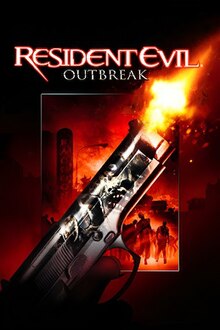Resident Evil, or Biohazard in Japan and parts of Southeast Asia, is a Japanese horror game series and media franchise created by Capcom. It consists of survival horror, third-person shooter and first-person shooter games, with players typically surviving in environments inhabited by zombies and other frightening creatures. The franchise has expanded into other media, including a live-action film series, animated films, television series, comic books, novels, audio dramas and merchandise. Resident Evil is the highest-grossing horror franchise.

Resident Evil 2 is a 1998 survival horror video game developed and published by Capcom for the PlayStation. The player controls rookie cop Leon S. Kennedy and college student Claire Redfield, who must escape Raccoon City after its citizens are transformed into zombies by a biological weapon two months after the events of the original Resident Evil. The gameplay focuses on exploration, puzzles, and combat; the main difference from its predecessor are the branching paths, with each player character having unique storylines, partners and obstacles.
Jill Valentine is a character in Resident Evil, a survival horror video game series created by the Japanese company Capcom. She was introduced as one of the two player characters in the original Resident Evil (1996), alongside her partner Chris Redfield, as a member of the Raccoon City Police Department's Special Tactics And Rescue Service (S.T.A.R.S.) unit. Jill and Chris fight against the Umbrella Corporation, a pharmaceutical company whose bioterrorism creates zombies and other bio-organic weapons, and later become founding members of the United Nations' Bioterrorism Security Assessment Alliance (BSAA).

Resident Evil 4 is a survival horror game by Capcom, originally released for the GameCube in 2005. Players control the special agent Leon S. Kennedy on a mission to rescue the US president's daughter, Ashley Graham, who has been kidnapped by a religious cult in rural Spain. Leon fights hordes of enemies infected by a mind-controlling parasite and reunites with the spy Ada Wong. In a departure from the fixed camera angles and slower gameplay of previous Resident Evil games, Resident Evil 4 features a dynamic camera system and action-oriented gameplay.

Resident Evil 3: Nemesis is a 1999 survival horror video game developed and published by Capcom originally for the PlayStation. It is the third game in the Resident Evil series and takes place almost concurrently with the events of Resident Evil 2. The player must control former elite agent Jill Valentine as she escapes from Raccoon City, which has been infected by a virus. The game uses the same engine as its predecessors and features 3D models over pre-rendered backgrounds with fixed camera angles. Choices through the game affect how the story unfolds and which ending is achieved.

Resident Evil 3 is a 2020 survival horror game developed and published by Capcom. It is a remake of the 1999 game Resident Evil 3: Nemesis. Players control former elite agent Jill Valentine and mercenary Carlos Oliveira as they attempt to find a vaccine and escape from a city during a zombie outbreak. The game is played from a third-person perspective and requires the player to solve puzzles and defeat monsters while being pursued by a creature called Nemesis. It was released for PlayStation 4, Windows, and Xbox One in April 2020 and for Amazon Luna, PlayStation 5, and Xbox Series X/S in June 2022, with a Nintendo Switch cloud version released in November 2022.

Resident Evil Zero is a survival horror video game developed and published by Capcom for the GameCube in 2002. It is a prequel to Resident Evil (1996), covering the ordeals experienced in the Arklay Mountains by special police force unit, the S.T.A.R.S. Bravo Team. The story takes place in July 1998 and follows officer Rebecca Chambers as well as convict Billy Coen as they explore an abandoned training facility for employees of the pharmaceutical company Umbrella. The gameplay is similar to other Resident Evil games, but adds the ability to switch between characters to solve puzzles and use unique abilities.
Ada Wong is a character in Resident Evil, a survival horror video game series created by the Japanese company Capcom. She was introduced as a supporting character in Resident Evil 2 (1998), before becoming a playable character in Resident Evil 4 (2005). Ada is a mysterious spy and mercenary who is often hired by villains, such as Albert Wesker, though she has betrayed her employers for her own agendas and saved protagonist Leon S. Kennedy from dire situations.
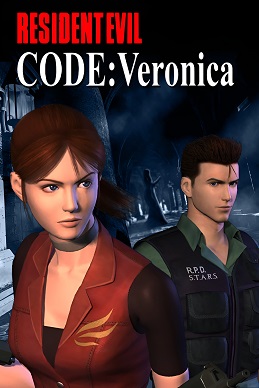
Resident Evil – Code: Veronica is a survival horror video game developed and published by Capcom and originally released for the Dreamcast in 2000. It is the fourth main installment in the Resident Evil series and the first to debut on a separate platform from the PlayStation. The story takes place three months after the events of Resident Evil 2 (1998) and the concurrent destruction of Raccoon City as seen in Resident Evil 3: Nemesis (1999). It follows Claire Redfield and her brother Chris Redfield in their efforts to survive a viral outbreak at a remote prison island in the Southern Ocean and a research facility in Antarctica. The game retains the traditional survival horror controls and gameplay of previous installments; however, unlike the pre-rendered backgrounds of previous games, Code: Veronica uses real-time 3D environments and dynamic camera movement.

Resident Evil Outbreak: File #2 is a survival horror video game developed and published by Capcom with online playability for the PlayStation 2. It is the sequel to Resident Evil Outbreak, and the final installment of the spin-off series. It was released on September 9, 2004 in Japan, on April 26, 2005 in North America, and August 26, 2005 in PAL regions.

Resident Evil: Dead Aim is a light gun shooter video game developed by Cavia and published by Capcom. It is the third Gun Survivor title in the Resident Evil series, and the fourth and final installment in the Gun Survivor series. It is also the third in the franchise to feature first-person shooting in the Resident Evil series.

Resident Evil: The Umbrella Chronicles is an on-rails light gun shooter video game developed by Capcom and Cavia as part of the Resident Evil series. The game was released for the Wii on November 13, 2007, in North America; November 15, 2007, in Japan; and on November 30, 2007, in Europe, excluding Germany, where the game is not available due to the refusal of a USK rating and its subsequent inclusion in the index. It was followed by Resident Evil: The Darkside Chronicles. Both Chronicles games are included on the Resident Evil Chronicles HD Collection for the PlayStation 3.

Resident Evil 6 is a 2012 third-person shooter video game developed and published by Capcom. A major installment in the Resident Evil series, Resident Evil 6 was released for the PlayStation 3 and Xbox 360 in October 2012, and for Windows in March 2013. It was re-released with all downloadable content for the PlayStation 4 and Xbox One in March 2016, and for the Nintendo Switch in October 2019. Players control Leon S. Kennedy, Chris Redfield, Jake Muller and Ada Wong as they confront the force behind a worldwide bio-terrorist attack. The story is centred around their four interwoven campaigns, and every campaign features a unique style in both tone and gameplay.
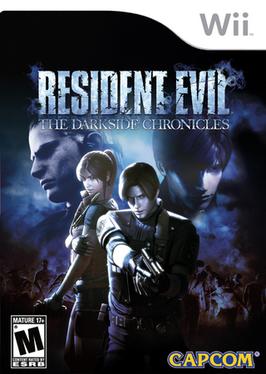
Resident Evil: The Darkside Chronicles is an on-rails light gun shooter video game for the Wii developed by Capcom and Cavia as part of the Resident Evil series. The game was released for the Wii on November 17, 2009, in North America. It serves as a prequel to Resident Evil 4, set 2 years before its events. It was released in Europe on November 27, 2009, bundled with the Wii Zapper accessory.

Resident Evil: Revelations is a 2012 survival horror video game developed and published by Capcom originally for the Nintendo 3DS handheld game console. Set shortly after the events of Resident Evil 4, the game follows counter-terrorism agents Jill Valentine and Chris Redfield as they try to uncover the truth behind a bioterrorist organization that plans to infect the Earth's oceans with a virus. The game features a single-player mode where the player must complete a series of episodes that involve solving puzzles and defeating enemies, and a multiplayer mode where players may fight their way through altered single-player scenarios.

Resident Evil: Operation Raccoon City is a squad-based third-person shooter video game for Microsoft Windows, PlayStation 3 and Xbox 360, co-developed by Slant Six Games and Capcom. It was released on March 20, 2012 in North America, March 22, 2012 in Australia, March 23, 2012 in Europe and April 26, 2012 in Japan.
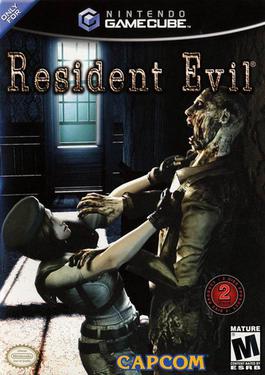
Resident Evil is a survival horror video game developed and published by Capcom. Released for the GameCube video game console in 2002, it is a remake of the 1996 PlayStation game Resident Evil, the first installment in the Resident Evil video game series. The story takes place in 1998 near the fictional Midwestern town of Raccoon City where a series of bizarre murders have taken place. The player takes on the role of either Chris Redfield or Jill Valentine, S.T.A.R.S. officers sent in by the city and the R.P.D. to investigate the murders.

Resident Evil Survivor 2 – Code: Veronica is a light gun shooter video game developed and published by Capcom as part of the Resident Evil series. The arcade version was developed in conjunction with Namco for the arcade machines. The game was released for Sega NAOMI and PlayStation 2. It was released on the PlayStation 2 on November 8, 2001 in Japan and in Europe on March 22, 2002. Whilst the Playstation 2 release is a light gun shooter, the NAOMI arcade release features no lightgun technology whatsoever, instead deferring control of each player entirely to a three-axis joystick in the shape of a gun. The game is the second instalment in the Gun Survivor series and the sequel to Resident Evil Survivor. The game is adapted from Resident Evil – Code: Veronica and features enemies and characters from that game, and enemies from Resident Evil 2 and 3. It was followed by Dino Stalker which is a spin-off of Dino Crisis, and has no ties to Resident Evil.
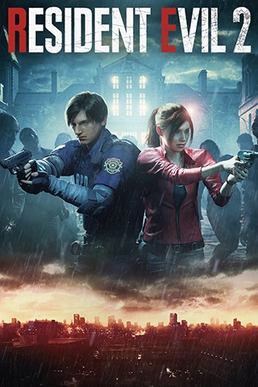
Resident Evil 2 is a 2019 survival horror game developed and published by Capcom. A remake of the 1998 game Resident Evil 2, it was released for PlayStation 4, Windows, and Xbox One in January 2019 and for Amazon Luna, PlayStation 5 and Xbox Series X/S in June 2022, and a Nintendo Switch cloud version released in November 2022. Players control the rookie police officer Leon S. Kennedy and the college student Claire Redfield as they attempt to escape Raccoon City during a zombie outbreak.
